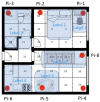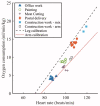Continuous Monitoring of Health and Mobility Indicators in Patients with Cardiovascular Disease: A Review of Recent Technologies
- PMID: 37420916
- PMCID: PMC10300851
- DOI: 10.3390/s23125752
Continuous Monitoring of Health and Mobility Indicators in Patients with Cardiovascular Disease: A Review of Recent Technologies
Abstract
Cardiovascular diseases kill 18 million people each year. Currently, a patient's health is assessed only during clinical visits, which are often infrequent and provide little information on the person's health during daily life. Advances in mobile health technologies have allowed for the continuous monitoring of indicators of health and mobility during daily life by wearable and other devices. The ability to obtain such longitudinal, clinically relevant measurements could enhance the prevention, detection and treatment of cardiovascular diseases. This review discusses the advantages and disadvantages of various methods for monitoring patients with cardiovascular disease during daily life using wearable devices. We specifically discuss three distinct monitoring domains: physical activity monitoring, indoor home monitoring and physiological parameter monitoring.
Keywords: activity recognition; biomedical monitoring; cardiovascular disease; electrocardiography; indoor localisation; patient monitoring; photoplethysmography; prognosis and health management; remote monitoring; wearable devices.
Conflict of interest statement
The authors declare no conflict of interest.
Figures































Similar articles
-
Advances in Cardiovascular Wearable Devices.Biosensors (Basel). 2024 Oct 30;14(11):525. doi: 10.3390/bios14110525. Biosensors (Basel). 2024. PMID: 39589984 Free PMC article. Review.
-
Remote Patient Monitoring for Neuropsychiatric Disorders: A Scoping Review of Current Trends and Future Perspectives from Recent Publications and Upcoming Clinical Trials.Telemed J E Health. 2022 Sep;28(9):1235-1250. doi: 10.1089/tmj.2021.0489. Epub 2022 Jan 24. Telemed J E Health. 2022. PMID: 35073206 Free PMC article.
-
Mobile Health Technologies in Cardiopulmonary Disease.Chest. 2020 Mar;157(3):654-664. doi: 10.1016/j.chest.2019.10.015. Epub 2019 Oct 31. Chest. 2020. PMID: 31678305 Free PMC article. Review.
-
5G Technology in Healthcare and Wearable Devices: A Review.Sensors (Basel). 2023 Feb 24;23(5):2519. doi: 10.3390/s23052519. Sensors (Basel). 2023. PMID: 36904721 Free PMC article. Review.
-
Wearable Devices for Precision Medicine and Health State Monitoring.IEEE Trans Biomed Eng. 2019 May;66(5):1242-1258. doi: 10.1109/TBME.2018.2871638. IEEE Trans Biomed Eng. 2019. PMID: 31021744
Cited by
-
Mobile solution and chronic diseases: development and implementation of a mobile application and digital platform for collecting, analyzing data, monitoring and managing health care.BMC Health Serv Res. 2024 Aug 31;24(1):1009. doi: 10.1186/s12913-024-11505-y. BMC Health Serv Res. 2024. PMID: 39217352 Free PMC article.
-
An AI-based module for interstitial glucose forecasting enabling a "Do-It-Yourself" application for people with type 1 diabetes.Front Digit Health. 2025 Jun 13;7:1534830. doi: 10.3389/fdgth.2025.1534830. eCollection 2025. Front Digit Health. 2025. PMID: 40585404 Free PMC article.
-
Recent Progress of Wearable Triboelectric Nanogenerator-Based Sensor for Pulse Wave Monitoring.Sensors (Basel). 2023 Dec 20;24(1):36. doi: 10.3390/s24010036. Sensors (Basel). 2023. PMID: 38202897 Free PMC article. Review.
-
Role of Mobile Health and Wearable Devices in Cardiovascular Disease Prevention: A Comprehensive Review.Cureus. 2025 May 7;17(5):e83673. doi: 10.7759/cureus.83673. eCollection 2025 May. Cureus. 2025. PMID: 40486456 Free PMC article. Review.
-
IoT-based remote monitoring system: A new era for patient engagement.Healthc Technol Lett. 2024 Aug 29;11(6):437-446. doi: 10.1049/htl2.12089. eCollection 2024 Dec. Healthc Technol Lett. 2024. PMID: 39720747 Free PMC article. Review.
References
-
- Ageing and Health. [(accessed on 1 March 2021)]. Available online: https://www.who.int/news-room/fact-sheets/detail/952ageing-and-health.
-
- Cardiovascular Diseases. [(accessed on 8 March 2021)]. Available online: https://www.who.int/health-topics/cardiovascular-diseases#tab=tab_2.
-
- Kan C.W., Lam Y.L. Future trend in wearable electronics in the textile industry. Appl. Sci. 2021;11:3914. doi: 10.3390/app11093914. - DOI
Publication types
MeSH terms
LinkOut - more resources
Full Text Sources
Medical

